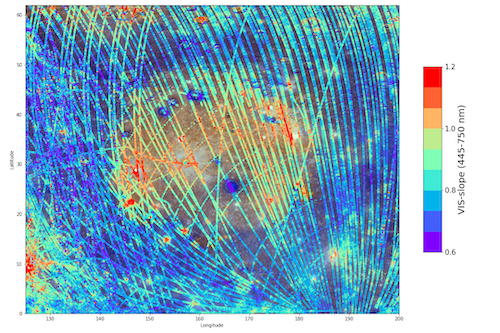Revealing Mercury’s surface properties through data mining of the MESSENGER datasets with MeSS
- Aurora for ESA, Villanueva de la Canada, Spain (sbesse@sciops.esa.int)
Introduction: The MESSENGER spacecraft has returned a wealth of data from Mercury that offers infinite research opportunities. The objective of our modest science team, the Mercury Surface Spectroscopy (MeSS) group, is to enable and maximise the science exploitation of the visible to near-infrared spectrometer (MASCS) onboard the MESSENGER mission to unravel Mercury’s surface.
The MeSS project is currently collecting research investigations of Mercury’s surface through data mining, knowing that the output of this work is of paramount importance for the preparation of BepiColombo’s exploration of Mercury.
Scientific topics for Mercury’s surface: In preparation for the next Decadal Survey, the Mercury science community defined in 2019 a list of high priority science at Mercury. The MeSS approach is supporting many of those high priority questions, and in particular those related to surface analysis. Are geological processes (e.g. formation of hollows and scarps) actively taking place today? How and why has volcanism changed so dramatically through time? To what degree have secondary processes affected the surface composition and mineralogy of Mercury? With the use of the MeSS, scientific users can explore those science questions with the MASCS observations.
The MeSS infrastructure: The MeSS database is a PostgreSQL relational database. This MeSS database contains the entire set of observations acquired by MASCS (i.e. >4.000.000 footprints) with all the relevant metadata to evaluate the MASCS data. Additionally, the MeSS database provide access to a product that combine the UV-visible and near channels of the spectrometer following the approach described in [1]. A view of the various parameters available in the MeSS database is presented in Fig 1. A python interface is available to provide query access to the database and explore the products of interest based on various criteria. Spectral parameters defined in [2] are also added as a table in the MeSS database. With the various information provided in the MeSS database, users can explore a combination of parameters of interest to explore the properties of Mercury’s surface.

Fig 1: Illustration of the various parameters and their relationships in the MeSS

Fig 2: Output of a query in the MeSS Database for the footprints with an incidence angle <75∞, a detector temperature <40∞, the visible slope as calculated in [3], and around the Caloris basin.
Results: After few years of development, and despite a slow down due to the pandemic, the MeSS database has been used to explore Mercury’s surface, and provide scientific results. [2,4,5] made use of the MeSS database to explore the mineralogical and physical properties of volcanic landforms. Our results have in particular highlighted the size of explosive volcanism and the asymmetry of some specific deposits. Hollows are small depressions on the surface potentially created by degassing of the sub-surface, and our latest analysis using spectroscopic data favour scarp-retreat as one of the mechanisms explaining the growth of hollows [3].
New collaborations are underway to investigate more scientific topics through the MeSS (space weathering, impact features, spectral properties of magnetic anomalies, etc.).
Future and collaborations: The content of the MeSS Database is rapidly evolving:
- New parameters are and can be added. In particular, the MeSS team is currently adding the spectral curvature calculated in [3].
- New datasets are always of interest to provide context to point spectrometers. The MeSS team is exploring the addition of MDIS and MLA data.
- Access to the MeSS database could be requested to the team. Currently, the infrastructure is not ready for a full public access, but the content is open for collaborators that want to explore Mercury.
Acknowledgments: The authors are very grateful to the SITU IT support team at the European Space Astronomy Centre (ESAC) for providing the required infrastructure.
References:
[1] Besse, S. et al. (2015), JGR, Spectral properties of explosive volcanism within the Caloris basin with MESSENGER observations.
https://doi.org/10.1002/2015JE004819
[2] Besse, S. et al. (2020), JGR, Spectral properties and physical extent of pyroclastic deposits on Mercury: Variability within selected deposits and implications for explosive volcanism.
https://doi.org/10.1029/2018JE005879
[3] Barraud, O. et al. (2020), JGR, Near-Ultraviolet to Near-Infrared spectral properties of hollows on Mercury: Implications for origin and formation process.
https://doi.org/10.1029/2020JE006497
[4] Rothery, D. et al. (2021), Icarus, On the asymmetry of Nathair Facula, Mercury.
https://doi.org/10.1016/j.icarus.2020.114180
[5] Barraud, O. et al. (2021), Icarus, Spectral investigation of Mercury’s pits surroundings: Constraints on the planet’s explosive activity.
Submitted
How to cite: Besse, S., Munoz, C., and Cornet, T.: Revealing Mercury’s surface properties through data mining of the MESSENGER datasets with MeSS, European Planetary Science Congress 2021, online, 13–24 Sep 2021, EPSC2021-102, https://doi.org/10.5194/epsc2021-102, 2021.

